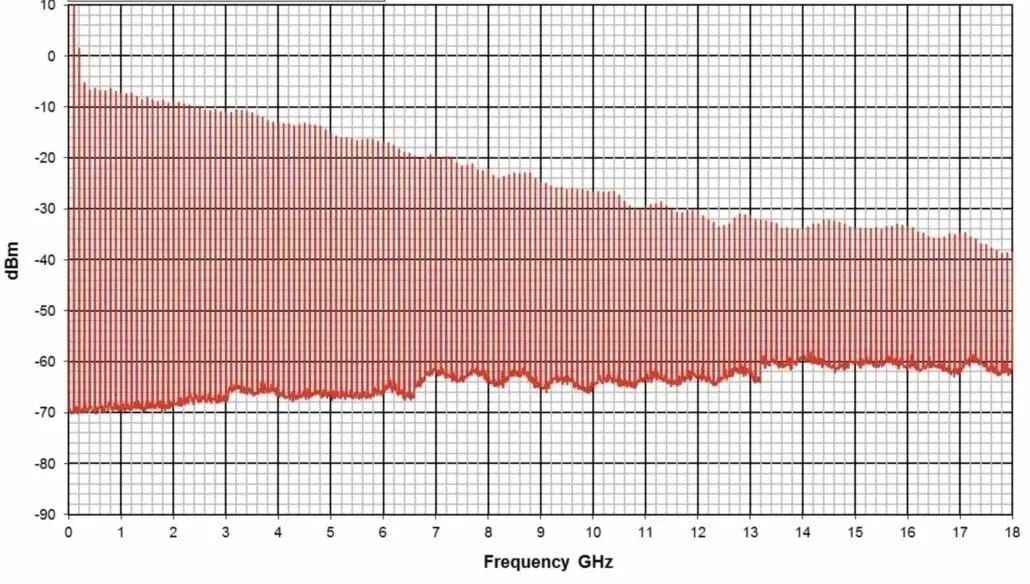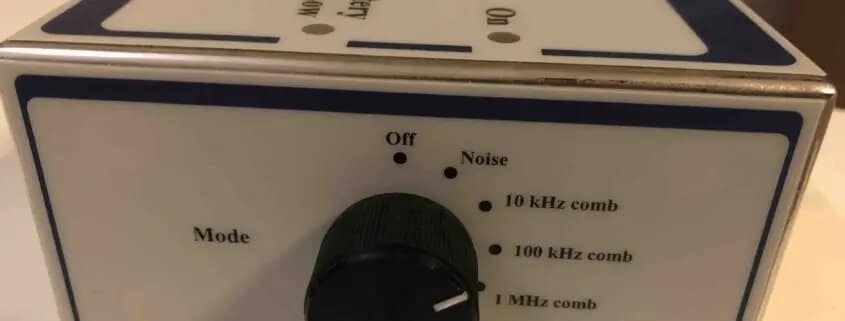Reference Sources are used to validate test setups. For EMC (ElectroMagnetic Compatibility) testing, references sources are signal sources for emission tests.
EMC labs calibrate their radiated emissions test sites, instrumentation and accessories annually or once two years. These calibration procedures are elaborate and time-consuming and may require other specialised test equipment. To improve the measurement accuracy and reliability, you have to check these items at closer intervals. It could be a daily procedure. Performing a full calibration each time might be costly. Reference sources will help you to check your test setups daily, just before starting the tests.
The problems with your measuring equipments may not be noticed during EMC testing and incorrect measurement data may result. A quick test using a Comb Generator can avoid this situation. Monitoring a few frequencies regularly on the Comb Generator’s broadband radiated output can verify the entire setup quickly and efficiently. Any potential problems with the test setup can be detected. In addition, Comb Generator data gathered over a period of time will provide information about the measurement consistency of the site. This will increase your overall confidence in the measurements made on the site. You can also use comb generators or noise sources as a reference source if you want to make Inter Laboratory Comparisons (ILC) which is required by IEC/EN 17025.
How to choose reference source?
If you need a comb generator or noise source to validate your EMC test setups, you can choose your reference source by following these steps:
1. Choose the tests to be validated: Test setups can be either for conducted emission or radiated emission EMC tests. Type of emission testing defines the technical parameters of the reference sources.
2. Choose the test setups to be validated: Determine the items of your test setups that you want to validate. If you want to a use reference source for Conducted Emission test setups with LISN, you have to choose LISN-compatible reference source. On the other hand, if you want to use a reference source for Radiated Emission test setup, you have to choose it to be placed in the test chamber and to radiate with its antenna.
3. Choose measurement frequency range: Reference sources can be used for measurements in a broad range: 9kHz to 40kHz. Each reference source has a limited frequency range. If you define your start and stop frequencies, this will make easier to choose your reference source.
4. Optimize your requirements: After choosing test types, test setups and frequency range, optimize your requirements to choose a reference source that will fulfil your requirements. For instance, you can choose a reference source which can be used both for conducted emissions and radiated emissions. Or you can narrow the frequency range of reference source if you do not measure some frequencies.
Comb Generator Models
Do you need a reference source (comb generator or noise source) for your EMC test laboratory? Send us your frequency and application details. We will offer you the models that fit your requirements.
Testups offers Reference Sources for EMC testing laboratories
Do you have an EMC testing laboratory? Time to validate your conducted emissions and radiated emissions test setups. Validation of your test setups will ensure your measurement accuracy. As stated in ISO / EN 17025 standard, comparisons and validation measurements are required for accuracy of measurements.
For EMC testing, every test needs specific type of reference source depending on the test applied. For emission measurements, reference sources are generally noise sources and comb generators. They are generating signals and you can compare these results with typical or previous measurement data of the reference sources. In this video YRS02 and CGE01 Reference Sources are presented. YRS02 is a combination of noise source and comb generator.It is a broadband noise and comb source that is capable of producing a continuous noise output from 9 kHz to 1 GHz, or a comb of frequencies within the 5 kHz to 1 GHz range, with step size being selected by the user. The noise generator enables observation of details over the full spectral range, while the comb generator allows for the reference signal output and noise floor to be viewed simultaneously, and the frequency accuracy of measurement equipment to be checked. The
Comb Generator Emitter 01 (CGE01) is a compact, battery powered, reference signal source that generates a broadband radiated and/or conducted output up to 18 GHz. When used as a verification reference source, the known output allows unknowns within systems or components to be measured or calculated. The compact size allows small enclosures to be evaluated when used as a reference source for shielding effectiveness measurements.

Typical output of a Comb Generator (0-18GHz)
Reference sources we offer
Comb Generator Emitter CGE01 (50 MHz to 18 GHz)
Comb Generator Emitter CGE05 (434 MHz to 26 GHz)
Comb Generator Emitter CGE06 (915 MHz to 40 GHz)
Comparison Noise Emitter V (9kHz to 1GHz)
Comparison Noise Emitter V+ (9kHz to 5GHz)
Comparison Noise Emitter VI (30Hz to 6GHz)
YRS01 Reference Source (noise: 9 kHz to 1 GHz, comb: 5 kHz to 1 GHz)
YRS02 Reference Source (noise: 9 kHz to 1 GHz, comb: 5 kHz to 1 GHz)
YRS03 Reference Source (noise and comb: 10 MHz to 6 GHz)
Price list is updated on 18 July 2023
If you downloaded before this date, renew it by downloading an updated price list:
Download Price List 2023
Validate your emissions test setups with reference sources
Choose any model listed on this page or send us your requirements. Then contact us and get your quote for reference sources. We are delivering references sources in 6-8 weeks to your address.

Recent Comments